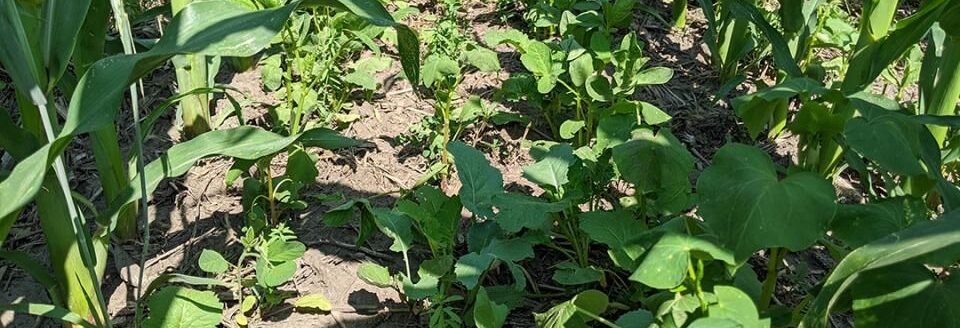In the heartland of American agriculture, a time-honored belief has prevailed for generations: High-yielding corn requires ample fertilizer.
For years, corn-belt farmers like Jay Young accepted this wisdom without question.
“I didn’t think that raising 200-bushel corn without applying nitrogen or phosphorus was a possibility,” said Young, a fifth-generation farmer in Greeley County, Kansas.
Four years ago, however, Young began to recognize soil as a finite resource. Success, he said, lay in understanding the soil’s health beneath his feet. He began a quest to change his farming approach, including how he managed his cornfields.
Some neighbors, he said, probably think he’s crazy. Nonetheless, his results have been remarkable. Over the past two years, Young’s experimental irrigated tests, devoid of nitrogen or phosphorus, has consistently yielded over 200 bushels an acre, and this year’s test plots show equal promise.
“It’s no myth that corn needs lots of nitrogen and lots of phosphorus to grow big and green,” he said. “The real myth is that you need to be applying it in large quantities.”
Here’s how he did it.
Young’s journey
Young’s introduction to cover crops happened unexpectedly in 2016 during a visit to a friend’s house to play cards. His friend’s daughter, discussing cover crops from her college class, sparked his interest. He returned home and began studying the idea, eventually sharing his vision with his father of utilizing cover crops in semi-arid western Kansas to fulfill his lifelong dream of establishing a cow-calf operation.
Young initially saw cover crops as a way to provide forage in a region with an average rainfall of 16 inches. His paradigm shifted in 2020.
Pondering ways to reduce nitrogen and phosphorus costs, he attended the High Plains No-Till Conference that winter. Speakers discussed how conventional agriculture approaches can harm ecosystems and eliminating phosphorus can improve soil health.
He also learned about the Johnson-Su bioreactor composting method. This method, which reintroduces beneficial microorganisms into the soil with the compost as biological inoculant. Trials showed that when farmers applied this extract in furrows with seed contact at corn planting, along with implementing a winter cover crop mix and other regenerative practices, they achieved good yields while significantly reducing synthetic nitrogen application by as much as 85%. Some completely eliminated phosphorus.
The results: higher profits, increased yields and a healthier soil system.
“I thought that was crazy,” Young admitted. “Yet, on the off chance it wasn’t crazy, and it worked, I wanted to do it.”
Remarkable results
Young said the secret to his success lies in the soil’s newfound receptivity to plant root exudates, the natural secretions that plants release to nurture beneficial microorganisms—an essential component of a thriving soil community.
His current method involves filling the bioreactor with damp materials like corn stalks, grass clippings, horse manure and wood chips—maintaining a 70% moisture content. These materials are farm-sourced, minimizing costs. He advises others to select locally available materials, preferably with 50 to 60% higher carbon content.
The year-long composting process fosters microbial growth and becomes a valuable soil inoculant when combined with a winter cover crop mix and grazing, Young said. His solution consists of combining 1 pound of compost with 4 gallons of water, applying 8 gallons of the extract per acre.
During his first testing in 2021, he applied 90 pounds of nitrogen and no phosphorus, achieving 242 bushels an acre on irrigated corn and reducing inputs by $100 an acre. In contrast, the standard rate of 180 pounds of nitrogen yielded slightly less—238 bushels an acre.
Despite challenges like drought and an irrigation pivot breakdown during the 2022 harvest, results again were impressive, he said. A 5-acre test strip with no nitrogen or phosphorus produced 207 bushels an acre, surpassing another strip with 50 pounds of nitrogen that yielded 204 bushels per acre.
Sign up for HPJ Insights
Our weekly newsletter delivers the latest news straight to your inbox including breaking news, our exclusive columns and much more.
Another irrigated strip with 100 pounds of nitrogen averaged 200 bushels an acre, while the entire circle averaged 214 bushels an acre. That same year, he raised 85-bushel dryland corn on only 40 pounds of nitrogen and no phosphorus. Rainfall during the growing season was 11 inches.
Jenny Rees, a University of Nebraska-Lincoln Extension educator specializing in on-farm research, has witnessed a growing interest among farmers in embracing sustainable practices. Factors such as rising input costs, environmental concerns and the anticipation of future regulations have spurred the exploration of alternative methods.
One pivotal driver is enhancing organic matter in soil. Rees emphasizes that organic matter not only improves nutrient availability but also enhances water-holding capacity. She meets with a group of farmers in the Seward County, Nebraska area who are researching alternatives and utilizing microbial tests and other strategies to bolster soil health while managing costs.
She said one farmer who has adopted the Johnson-Su method has reduced nitrogen by 90 pounds an acre.
Another Seward County farmer she works with, Todd Schmieding, started conducting experiments in 2022. Schmieding said he used the Johnson-Su method on a 16-acre research plot and had promising results. Schmieding tested four different treatments, including one with his normal nitrogen and starter fertilizer rates. He compared it with two compost types—the Johnson-Su method and a traditional turn pile, where he applied 40 pounds less nitrogen per acre.
The plots where compost was applied saw a slight dip in yields during the 2022 harvest, however Schmieding highlighted that conventional farming and his trial yielded similar economic outcomes that were not statistically different.
He said he repeated the trial in 2023 making some adjustments to try and show if the compost extract added to the yield when nitrogen was reduced.
As for Young, he hasn’t applied phosphorus to his corn or sorghum crops since 2000, anticipating even better results this year. He said he’s received almost 17 inches of rain this season.
The United States is losing topsoil every year at a rate that isn’t sustainable, Young said. That’s why he wants to make a difference for the next generation.
“I have changed the way I think,” he said. “I don’t see myself as someone who inherited the farm from my forefathers. I am borrowing this farmland from the future descendants and the next generation. I must be a good steward of what I have so I can give it back to them.”
Amy Bickel can be reached at [email protected].




